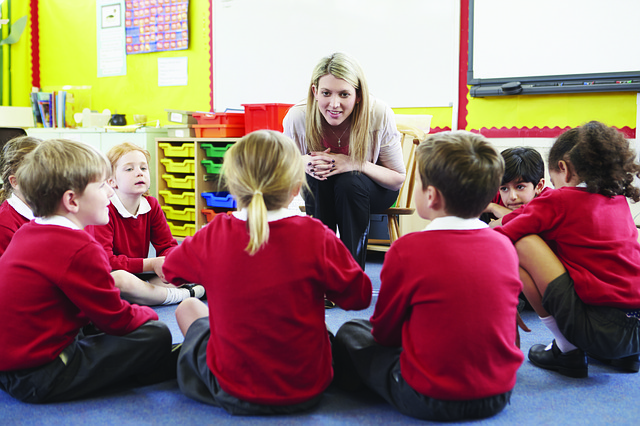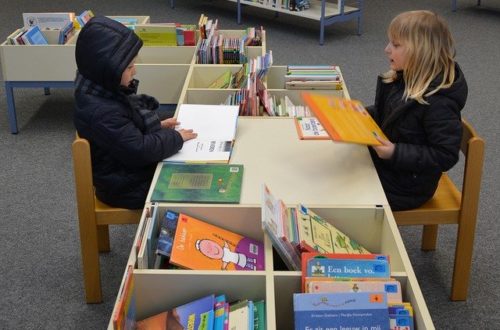I remember the first time I encountered Fountas and Pinnell very clearly. I was sitting in a room with about twenty other teachers in my first class in a teacher training program eight years ago. I was holding this big, voluminous textbook authored by Irene Fountas and Gay Su Pinnell. I knew nothing about how to teach reading at that point. I had learned on Siegfried Engelmann’s Reading Mastery, and on the Wilson Program, in first grade when I myself was a struggling reader. Back in 1995, it was the heyday of Whole Language, and guessing at words and sounds. Not having been born with an innate knowledge of ancient Phoenician symbols, it wasn’t clicking for me. I’d had a great relationship with my teacher, but I wasn’t learning to read. I never thought, not for one second, that I’d ever find myself in a classroom learning to be a teacher. It wasn’t anywhere on my top ten list of careers, or even my top twenty. And yet, here I was prepared to start the process of acquiring my license. Other than having my background in direct instruction, and having been taught to read very proficiently that way, I had no other keystone in the structure of my understanding of literacy. We were asked to read the opening remarks of the book to start off this day-long class. “This is the only way to teach reading,” the teacher of the class joyfully declared. I read this opening page about what was to follow, and the methodology behind the program, and I thought “this doesn’t make any sense.”
The very first thing that struck me was that the program was talking about teaching kids to read as if we would just hand them these little books full of pictures, and expect them to be able to do it. I was reminded of Louis Pasteur’s encountering the theory of spontaneous generation that preceded his own discoveries in microbiology: life forming out of thin air with no precursor. I had learned my sounds, and sound combinations before anything. I also remembered blending and manipulating the sounds in words before I even got to a real book. The exact details of my own reading experience are hazy. I can remember struggling, and I can remember not struggling anymore, but not the in-between time. I remember the tutor, and the location, but the architecture of my literacy skills has faded, and I am left with the automaticity of decoding text. I was confused by what I was reading in Fountas and Pinnell’s book, but my confusion turned to outright shock as the class continued, and I was thrust into the world of balanced literacy. I also discovered that this method was derived from the same method of teaching reading, Whole Language, that had failed me years ago. I very clearly remember how I felt as that kid in class sitting there nonplussed by the lessons. Whenever it was time to read, I would sit and pretend to do so because the code made no sense to me.
I have taken a much deeper dive into the world of literacy since, and have spent most of my efforts working with students with dyslexia, where the harm caused by balanced literacy is more obvious, because these students are pre-disposed to struggle with reading from an early age. The premise of programs like Fountas and Pinnell is that there is supposed to be a balance between the demands of direct instruction, such as explicit phonics instruction and phonological awareness, and the precepts of Whole Language, which involves having children figure out the meaning of text from context clues and images. Students who experience balanced literacy are supposed to get the best of both worlds, the freedom and creativity of Whole Language, and the rationalism of direct instruction. Whole Language/constructivist backers like to portray things this way, with themselves as heroic, creative, compassionate underdogs bravely fighting the good fight against rote memorization (which is what they think of when considering early literacy skills). They use direct instruction to mean the teacher presenting information on the board and talking directly to the class, but not directly teaching skills. The only problem is that balanced literacy is much more focused on developing a love of literature than it is on teaching basic foundational skills, which, they assert, will come naturally because children are “natural pattern makers.” This question of making meaning from text is an age old one in the struggle between rationalists and constructivists, between those advocating for teaching basic foundational skills, and those who want kids to jump right into reading. By calling themselves balanced, whole Language won the argument on a rhetorical level, because no one is going to argue against mediation, and an attempt to find common ground. Whole Language, under the guise of balanced literacy, asserts that children can make meaning during play and from socializing, and ergo they must also be able to do so with text too. Direct instruction is based around the idea that these skills are not natural or inherent, and must be taught explicitly, and, well, directly. Instead of singing rhyming songs and playing games with the sounds, direct instruction teachers simply teach the connection between the letter and the sound, or teach the pattern. Games and songs are by no means a bad thing, and can be a part of any classroom, but they don’t teach reading skills. Fundamentally, teaching reading as if it is a social skill, and that it can be acquired as easily as our ability to speak or to engage with others, creates a confusing and unrealistic picture of what it is like to learn to read. This depiction is not based on science or fact, but rather on the beliefs of people who want reading to be fun for children, and not realizing that it will only be fun if children can actively engage in the process because they have the skills to participate. I am hardly the first, nor will I, sadly, be the last kid to sit on one of those reading mats pretending to read a book in first grade, feeling terrible about myself as a result.
Fountas and Pinnell, and balanced literacy, the new face of Whole Language, is featured in schools all over the country. Problem solved, right? We got both sides to agree. Unfortunately, this is not what happened. Balanced literacy, and programs like Fountas, simply added a brief nod to phonics in their work so they could check off that box. Nothing fundamentally changed about the approach other than being able to say that they found a compromise, they were willing to extend the olive branch, and that both methodologies could exist in harmony. It rendered the argument in favor of teaching skills directly and explicitly moot in favor of a farcical folkloric approach to reading that has no basis in fact. Teaching kids to learn through literature, or teaching “the whole child” simply sounds nicer on paper and, more importantly, in parent meetings. Fountas and Pinnell is an incredibly popular program with teachers, and most training programs use it as the program they equip teachers with. Schools will spend a fortune on additional training, and they will stock their literacy closets with hundreds of leveled texts, the modified set of books from level A to Z that will correspond with a child’s reading level. Teachers will help kids find their “just right book,” instead of checking their reading rate.
Rather than focus on how best to help a child acquire foundational skills like blending sounds, decoding words, or identifying which letters make what sound, students are instead given the Fountas and Pinnell assessment, the BAS, and their “just right book” is determined, as well as their instructional level, and the level just above their instructional level. All of this is based on the Fountas and Pinnell books rather than any assessment of skills outside of these books. Students gather in small groups with a teacher on most days for guided reading practice. This simply means the teacher is there to offer guidance as the children read from these books they haven’t really been taught to decode. There are usually pictures, and it is assumed kids can connect the words with the pictures to figure out the word in context. The children are also assessed three times a year with the BAS to see if they have moved from say level N to level P. No daily progress monitoring exists to determine if their skills are advancing, but parents get the impression their kids can read because they see their children holding books and seemingly reading the words on the page. They have no idea their kids aren’t being taught to decode.
Given that these books are not calibrated for grade level, or by decodable pattern, but rather by the appearance of being easier or harder, the assessment says nothing about the kids’ progress. You simply learn if a kid can read a P book and an N book, and little else. This is not data, it is simply a measure of how well a child can memorize a leveled text they see every day, until they are ready to move to the next book. They aren’t taught the patterns of syntax or the vocabulary, or the sound patterns present. They are simply asked to read books that look like maybe they could be a first-grade book, or a fourth-grade book. Your typical reader will, given the prevalence of text, be able to memorize or guess at the words in the books used on the assessments, and at their general level in the program. They will be able to read in the sense they can repeat back the simple stories in these books, and they will know those words in the book through memorization, but they won’t be able to apply any broad principles beyond Fountas books. This particular issue doesn’t come home to roost for years.
If the students come from a literate background, and have educated family members, their inability to read gets further obfuscated by their access to background knowledge and their verbal ability in an oral sense. If they can speak fluently, and with good vocabulary, then they must be able to read too, right? Most struggling readers are simply never taught phonics or decoding skills explicitly, and the damage only really surfaces in high school, and sometimes middle school, when more complicated texts, and more nuanced stories are introduced. Then we see the limitations of learning such a small fraction of the language, and in such a stunted fashion. Proficient readers, by contrast, are able to broadly apply their skills to unfamiliar words, and they can use their knowledge of the sounds letters and letter combinations make to decode complicated words such as prestidigitation or inconsequential. If you still have to figure out decoding as you are reading to comprehend, your brain will be doing two jobs at once, and not doing either very well.
Fountas and Pinnell, as well as other balanced literacy programs, places a great deal of emphasis on this guided approach to reading and group work because, fundamentally, they see reading as a social activity, rather than an individual’s ability to decode text, something that happens in the confines of the brain in the reading circuit. They focus on comprehension first, and then go back to look at the skills that get you there, which is the opposite of what the research tells us is effective. Fountas and Pinnell bill themselves as research-based, and as adhering to the principles of good reading instruction, and yet the foundational skills aspect of instruction that is supposedly balanced with the unproven, and untested components of a theory derived from the 1700s, is hardly balanced. The attention paid to phonics and phonological skills, as well as decoding, is an afterthought, a lesser burden than instilling a joy of reading or comprehending a text. It’s certainly easier on the teacher not having to directly teach those skills, and the reading block takes less time, which is something that makes administrators happy, and that’s why this system works for the people running the curriculum, because both teachers and administrators are on the same page. More time to prep for state tests, and common core assessments, that students may or may not be able to read. Occasionally they might feel compelled to add a brief phonics piece to go with the bulk of their balanced literacy constructivist programming, but nothing that really requires time spent on explicit instruction. It’s a checklist to say all the pieces of a good reading program have been covered. The other end of the scale is there to pay lip service to the criticism that Whole Language is a fundamentally flawed and broken approach, with no research behind it.
For myself, I have yet to meet a balanced literacy proponent who has been able to share research or progress monitoring that hasn’t been written by someone from a company selling the balanced literacy products. People tend to forget that the people selling the program, shouldn’t also be the people researching its efficacy. There is an always unseen massive body of research alluded to, but never seen…a unicorn in the forest, and you’d have about as much luck tracking down the research, as you would finding that unicorn. Students reading Fountas and Pinnell books would certainly have trouble decoding a word such as unicorn, ironically enough. The core issue with Fountas and Pinnell is that it is an illusory practice of creating balance, and maintaining a positive social atmosphere, instead of directly teaching the skills, and doing the job any good reading program is meant to do. Having a joyful, classroom is great, it’s desirable, but kids also need to know how to read before you hand them a book. Just like microbiology, learning a skill like reading doesn’t spontaneously come into being. Fountas and Pinnell, and the programs like it, are putting the cart before the horse, and attempting to have kids read, without teaching them to read.






2 Comments
Ronald Carter
So are there any reading programs that are researched based that you would recommend-preferably for middle school?
Chris Muzilla
It depends on the student, or group of students. If you’re talking about middle school, I assume either small intervention group or individual students. REWARDS and Corrective Reading are good for groups. Maloney Method, which is a direct instruction program as well (from Sigfried Engelmann’s direct instruction programming) is a good 1:1 program for kids, and can also work with groups. The fluency piece is incredible. Check out the newest Project Follow Through for the peer-reviewed data. Follow Through is the most expansive, and thorough comparison of different reading programs around. Certain kids are going to struggle more than others so it’s good to have a few evidence-based programs on hand. Spelling Through Morphographs is good to have on hand as well.